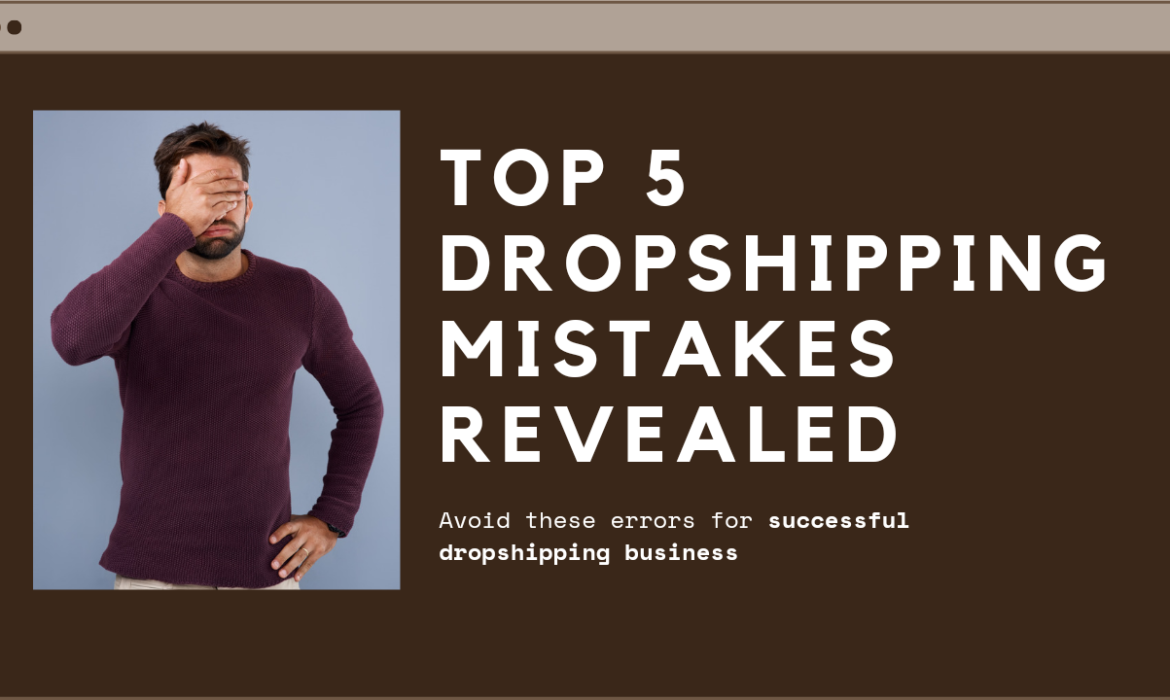081-4797-7173
Dropshipping has become a popular e-commerce model, offering entrepreneurs an easy entry into the online business world. With the ability to sell products without holding inventory, it promises flexibility, low investment as well as scalability. However, while the potential for success is high, the road to success is filled with common mistakes, especially for beginners.
As a newcomer, it’s important to avoid these pitfalls to ensure your dropshipping business thrives. In this article, we will explore the top five mistakes that beginners often make and provide practical tips to avoid them. By addressing these challenges early on, you can set your business up for long-term success.
Mistake 1: Neglecting Product Research
One of the biggest mistakes a dropshipper can make is neglecting proper product research. It’s easy to get caught up in the excitement of starting a business, but without selecting the right products, your chances of success will be limited.
Why Product Research Matters
Product research is essential because it helps you identify what customers want, ensuring that you sell products that are in demand. If you overlook this step, you might end up selling items with little market interest or poor sales potential. Additionally, trends can shift quickly in the e-commerce world, so staying on top of what’s popular is critical.
Consequences of Poor Product Selection
Selling irrelevant or outdated products can lead to stagnation in sales, negative customer feedback, and a lack of repeat business. It’s essential to understand your niche and the pain points your target audience is looking to solve.
To avoid this mistake, take time to research market trends, customer preferences, and the competition. Use tools such as Google Trends, social media platforms and competitor analysis to get insights into what products are trending.
Mistake 2: Partnering with Unreliable Suppliers
A reliable supplier is the backbone of any successful dropshipping business. Unfortunately, many beginners make the mistake of rushing into partnerships with suppliers without considering their reliability. This mistake can lead to delays, poor-quality products as well as dissatisfied customers.
Why Supplier Reliability Matters
Working with unreliable suppliers can cause a range of problems, including stockouts, delayed shipping, and poor product quality. Furthermore, these issues directly impact customer satisfaction and your store’s reputation.
How to Vet Suppliers
Before committing to a supplier, make sure to research their reputation. Look for reviews, check their responsiveness to queries, and ask for product samples to assess quality. Consider working with suppliers who offer transparent communication and excellent customer support.
Platforms like AliExpress and SaleHoo can help you find trustworthy suppliers, but it’s still vital to vet each one thoroughly.
Building a strong, trustworthy relationship with your suppliers will ensure smoother operations and a more positive experience for your customers.
Mistake 3: Overlooking Marketing Strategies
A successful dropshipping business needs more than just a good product and a reliable supplier—it also needs a solid marketing strategy. Many beginners make the mistake of focusing too much on their store setup and not enough on driving traffic and sales.
The Importance of a Marketing Plan
Having a clear, comprehensive marketing plan is essential for driving traffic to your website and also turning visitors into customers. Without it, even the best products will fail to reach their target audience.
Common Marketing Mistakes
Some entrepreneurs rely too heavily on a single marketing platform, such as Facebook Ads, or overlook the power of social media platforms like Instagram, Pinterest, and TikTok.
Additionally, neglecting email marketing and SEO strategies can limit your visibility and growth potential.
To avoid this mistake, create a marketing plan that spans multiple channels.
In addition, focus on building an online presence through social media, SEO, email marketing, and paid ads. Experiment with different platforms and tactics to find what works best for your niche.
Mistake 4: Ignoring Customer Service
Customer service is often overlooked by beginners, but it’s a vital aspect of any business. A single negative interaction with a customer can damage your reputation and result in lost sales.
The Impact of Poor Customer Service
In today’s digital world, customers have high expectations when it comes to support. Delayed responses, unhelpful interactions, or lack of transparency can quickly result in negative reviews and damaged relationships with customers. This can lead to a decrease in customer retention and brand loyalty.
How to Provide Excellent Customer Service
To avoid this mistake, be proactive in handling customer inquiries, complaints, and returns. Set clear expectations about delivery times and keep customers informed about any delays. Offer multiple communication channels, such as email, live chat, and social media, so customers can reach you easily.
Customer service should always be a priority. A happy customer is more likely to make repeat purchases and recommend your store to others.
Mistake 5: Failing to Track Metrics and Performance
Another common mistake is neglecting to track and analyse key performance metrics. Dropshipping businesses can’t rely on guesswork. Understanding your sales, traffic, conversion rates, and customer behaviour is crucial for scaling your business and improving profitability.
Why Tracking Metrics Is Important
Without tracking metrics, you’ll struggle to make informed decisions. You might miss opportunities to improve your conversion rates, optimise your ads, or increase customer retention. Tracking helps you understand what’s working, what’s not, and also where to focus your efforts.
How to Track Your Performance
Use analytics tools such as Google Analytics, Facebook Pixel, and your e-commerce platform’s built-in analytics to monitor key metrics. Track sales, visitor numbers, bounce rates, and other relevant data to get a clear picture of your business’s performance. Also, regularly reviewing this data allows you to adapt your strategies and make data-driven decisions.
How to Avoid These Mistakes
Now that we’ve covered the top five mistakes beginners should avoid, let’s briefly recap how you can avoid them:
- Conduct thorough product research to ensure you sell in-demand items.
- Vet suppliers carefully to ensure reliable partnerships.
- Build a comprehensive marketing plan that spans multiple platforms.
- Prioritise customer service to create loyal, repeat buyers.
- Track key metrics to make informed, data-driven decisions.
By implementing these steps and continuously learning from your experiences, you’ll be well on your way to building a successful dropshipping business.
Conclusion
Avoiding these common dropshipping mistakes will significantly increase your chances of success. By focusing on product research, choosing reliable suppliers, crafting a solid marketing strategy, prioritising customer service, and tracking performance, you’ll be able to scale your business and stay ahead of the competition.
Start implementing these strategies today and watch your business grow. If you found this article helpful, don’t forget to share it with other aspiring entrepreneurs, and also feel free to leave your thoughts or questions in the comments below.
0






